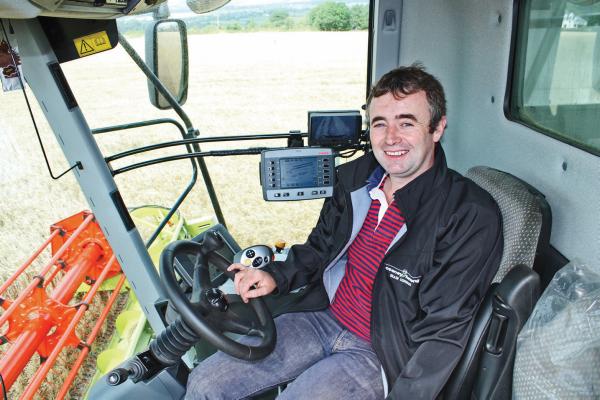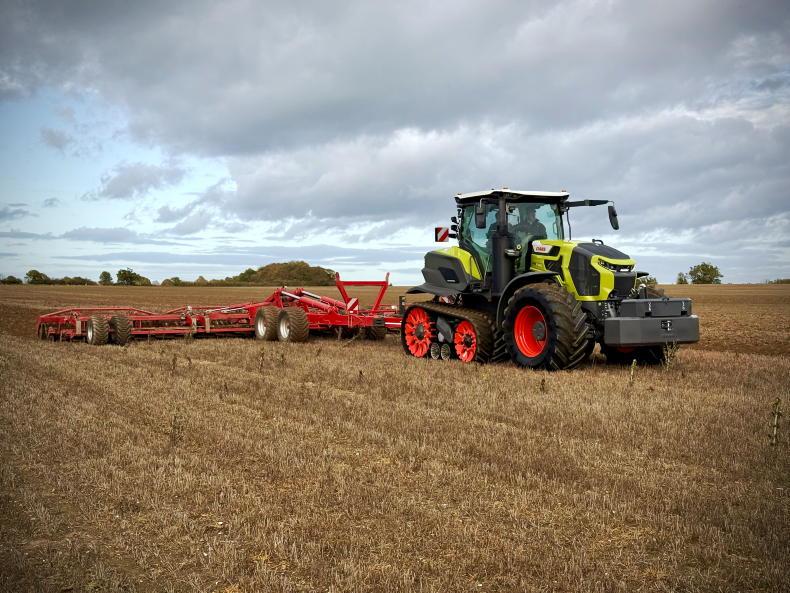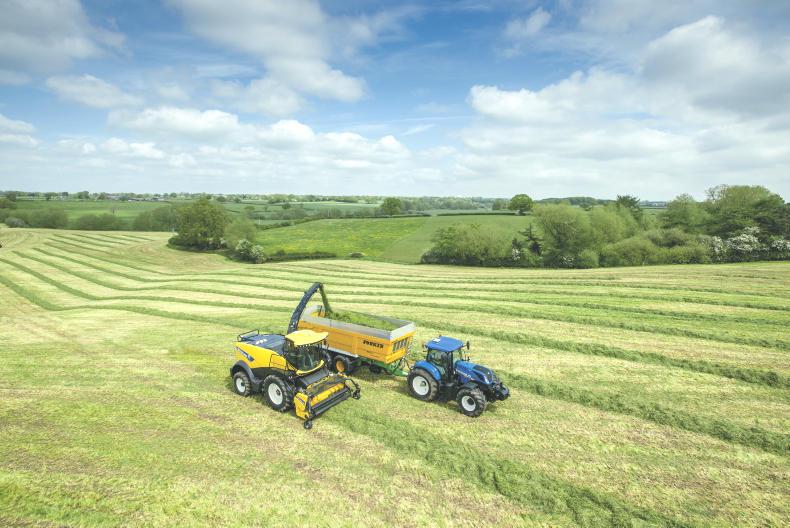One firm in the south east, with a lot of cereals to harvest has upgraded its existing pair of rotary combine harvesters, replacing them with Claas two rotary flagship models.
Walter Furlong Grain Ltd, based outside Enniscorthy, Co Wexford, invested in two new Claas Lexion 780TT combine harvesters, both running on tracks and operating with 10.5m (35ft) Claas 1050 Vario headers. This farm business grows in the region of 3,000 acres of cereals and has been running two combines for five years to cope with the harvest.
“About two thirds or 2,000 acres of what we grow is spring barley. Winter oats and winter wheat make up the remainder,” said Philip Reck, farm manager at Walter Furlong Grain Ltd. “The soil in this part of the country suits barley, in particular, and yields between three and 3.5 tonnes are achievable,” Philip said.
“Our aim at Walter Furlong Grain Ltd is to develop and produce high quality barley for malting and distilling, plus high quality oats for the equestrian market.”
Producing so much spring barley, winter oats and winter wheat leads to its own headaches as most of it ripens at the same time. With the type of cereals grown and the industries they are grown for, colour and bushel are extremely important, said Philip.
“Generally, we have a 15-day harvesting window in Ireland. After that, colour and quality degrades. It is extremely important to harvest on time so we need to be able to harvest at least 200 acres per day,” he said.
While Philip would feel that the Claas 780s are at the top of the rotary harvester league, he concedes that after last harvest the firm was looking at walker machines as a possible replacement for its two existing combines.
||PIC2||
“Last year, rotary combines had problems with the tough straw and conditions, reducing their capacity while conditions didn’t have such a severe effect on walker machines.
“Despite one very wet year, we felt it was the right decision to stick with rotary machines because in good conditions they have a harvesting capacity advantage over walker machines,” he added.
Threshing options
The pair of Claas Lexion 780 TTs have a theoretical working window of 15 days to harvest 3,000 acres. This sets the minimum average harvesting capacity per combine at 100 acres/day.
Looking at a yield of three tonnes/acre means that the pair of Lexion 780TTs combined have a target throughput of over 600 tonnes/day. That’s all dependant on the weather and any other variables which enter the harvesting frame.
||PIC3||
Harvesting figures would be far higher in high yielding wheat crops in much larger fields than would be the norm in Ireland. Philip said: “Barley is more difficult to harvest; it is far easier to achieve higher outputs when cutting wheat. You are looking at close to 110 acres each per harvester per day, at a yield of 3.25 tonnes/acre; this is almost 360 tonnes/day each.”
Either way, that’s a lot of harvesting, so how is it done? At the front of each Lexion 780TT there is a 10.5m (35ft) Claas 1050 Vario header. Paired, they cut a massive swath in a single pass. At that width, there are two synchronised knives driven from each side of the header.
The Vario aspect of the header allows the knife assembly distance, between knife and auger, to be adjusted hydraulically anywhere from 480mm to 780mm.
||PIC4||
For rapeseed, the harvesting floor can be manually set to 1,080mm with the addition of spacers but it is not adjustable.
The Claas APS Hybrid Threshing System incorporates a pre-accelerator drum in front of the main threshing drum and a rear beater drum after the main drum. These are laid out in conventional combine style. Behind the rear beater, the walkers are replaced by two rotors which perform the final separation process and deliver the straw out the rear of the combine, or to the straw chopper.
The pre-threshing drum is a key element in increasing the harvester’s capacity. It evens the crop before it enters the main drum.
Claas claims that this system gives a 33% faster crop flow through the main threshing area, increasing conventional drum and concave capacity. The ROTO PLUS twin rotors behind the main threshing unit are each 445mm in diameter and 4.2m long. Rotor speed on the 780s can be varied from the seat with the Cebis rotary switch anywhere between 450rpm and 1,250rpm.
||PIC5||
Distance between rotor and separation area is similarly adjustable. Additional hydraulically operated shutters increase or decrease the separation area, as required.
As this year clearly demonstrated, straw is a valuable commodity and requires some care to manage it properly and produce good bales. Both 780s feature straw separators, which were made to split the straw from the two rotors as it leaves the machine. They leave two rows instead of one very large one.
“We had these made for the combines to split the swath and allow it to dry easier than it would in a big one. Before baling, we rake the two back into one,” Philip said.
Tracks not tyres
Both combine harvesters run on tracks rather than wheels. This is not for traction reasons, Philip explained. “We didn’t have a problem of sinking anywhere, not even last year. We specified tracks because we can manage to move the combine harvesters around much easier.
“Four-wheel-drive is equal, maybe better, than tracks for boggy conditions. On tracks, the Lexion 780TTs are just 3.45m (11’ 6’’) wide versus over 4m (13’ 6’’) for a wheeled combine of that size,” added Philip.
Automatic pilots
James Quirke and Mick Sharkey pilot the two combine harvesters. They are helped by lots of monitoring and control options. The pair of Lexion 780TTs have the Claas Cebis, Cemos Automatic, Cruise Pilot and Telematics systems.
Cebit is the main monitoring and operating system, displaying all relevant data from forward speed and grain losses to header height.
Cemos Automatic takes combine threshing settings out of the operator’s hands. It continually adjusts them to maximise combine throughput as field conditions change, from light to heavy, dry to damp.
Cemos Automatic adjusts rotor speed, rotor flap position, fan speed upper sieve and lower sieve. Philip would question how often you change or adjust combine settings to suit different conditions. The Claas Cruise Pilot system automatically adjusts the forward speed of the harvester according to load placed by the crop entering the combine and rear losses.With the Cemos Automatic with Cruise Pilot, you have a combine harvester that works to its maximum efficiency or whatever level of efficiency is determined by the operator.
Initially, Philip was sceptical about how much of a gain there would be in harvesting capacity utilising Cemos Automatic and Cruise Pilot. He was not confident that they would provide more output than the operators alone.
Pleasantly surprised, they found that the combines have considerably more output running these systems. “Automatic adjustment of forward speed was the most unnerving for Mick and James until they learned to trust the combine,” Philip said.
Another surprise has been the quality of the straw which Philip attributes to a combination of the harvesters control systems and special Claas TM6 frog-mouth sieves they had specified with the harvesters.
“Claas were a bit reluctant to provide the TM6 sieves but we have found that they provide an extremely good grain sample, very clean. They allow us to use lower rotor speeds and that contributes to the quality of the straw.”
The Claas Telematics system provides remote access to the combine harvester through the mobile phone network. The system also allows the dealer, in this case Kelly’s of Borris, to access the harvester. The field yields are a very important piece of data provided by the Telematics system, according to Philip. Cereal yields across individual fields are defined by information recorded by the combine harvester.
This data is then imposed on a Google map of the same harvested fields. This helps to build up a picture of field performance, if soil testing is required, and management of fertilizer/chemical application can be optimised.
To help both drivers —Mick and James — get to grips with the technology, Alex Day from Claas went through the combines. Alex’s training was excellent, said Philip. “The 780s are everything they’re cracked up to be”.













SHARING OPTIONS